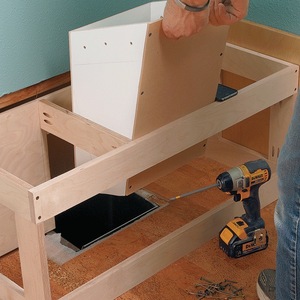My well pump quit on Tues, we noticed it Wed AM. Called & the guy got to the house Wed around 2PM. Verified electric to the pressure switch w/ a little light up tester and my non-contact beeper. He decided it had to be the pump (that his company installed 3 yrs ago). Talking about warranty, I told him of a “flash” my wife saw Tues eve but there was no evidence of lightning and the evening had been clear.
They ordered a pump, had it the next day and pulled the (3 yr) old one w/ some difficulty Thurs AM, the pitless would not let go. Finally got it up & out, checked the electric connections and found 110V on each leg going down the hole. They installed the new pump, flipped the breaker and NOTHING. Replaced the 3 yr old pressure switch…NOTHING. Pulled the new pump thinking it was also bad, took both back to the shop to “bench test” them.
That eve we notice the AC wasn’t working. We had found the dryer was running but wasn’t heating, so I figured my 220 service was not working, called the utility first thing Fri and they showed at 9:30 or so. One of the legs into the house had burnt/corroded through and we had only 110/120 into the house. The plumber had both pumps and said they ran at the shop so based on what the linemen found, they re-installed the old pump and we’re back to civilization.
I believe that they should have known RIGHT AWAY that I was only getting 110/120 to the pump. I’m told that when they finally put MY multi meter on it and it read 110 on each leg, they were correct in assuming it was 220. They also said that the breaker was reading 110 on each terminal, that there was no way for them to know so I owe ’em for all the time they fiddled around.
They finally agreed to step on the bill ($1,300), but even at half, I got basically NOTHING. I feel I should only pay for the initial call when they should have advised me of the power problem. Sorry to go on so long, I may have to furnish this much detail to a guy (or a gal) in a black robe!!!


















Replies
batman
I am no electrician, but beep testers (20.00) is no way for a service tech to check line voltage.
1/2 is 1300.00?
yikes.
In my mind, being only a dumb carpenter, but having a voltage meter if I read the directions which I did keep...........I would be equally pis'd.
Your giving the info of the flash w/o storm or lightning might have tipped someone into thinking not enough juice, but not necessarily-so............
Best of luck.
plumber's mistake
Thanks for the feedback, the total is $1300, they proposed half, I MAY shoot 'em a couple hundred but no way even going to $650!!! Thanks again.
plumber's mistake
Thanks for the feedback, the total is $1300, they proposed half, I MAY shoot 'em a couple hundred but no way even going to $650!!! Thanks again.
They should have checked for 240 volts to the pump first, I agree with you. They screwed up, and did the initial install, they should eat the extra cost.
My take on it is that it was bad luck. They tested for voltage. No reason to suspect they didn't have adequate amperage.
If they offer to split the bill it sounds reasonable to me. This was after all a plumber, not an electrician.
Since this is all so murky, I'd agree that a split on the bill is the fair thing to do. That is, as long as the charges are reasonable.
But, why didn't you or the pump guy, simply check for 240 volts at the pressure switch. I'm no electrician but that's what I'd have done... wouldn't have ever had the notion to check each leg independently.
By the way, in my experience, a competent well/pump guy will have replacement pumps on his truck when he drives up, along with all the necessary diagnostic tools, and items for replacement. Why did he need to borrow your multi-meter at all? That should have been a clue.
Me?
I'd pay them for a service call.
What did they do? They made a service call. It was their misidagnosis of the initial problem which lead to additional labor. In the end you got nothing from them but a house call.
So I'd pay for the service call. If I was in a good mood I'd toss in a tip of lunch money for them.
"Finally got it up & out,
"Finally got it up & out, checked the electric connections and found 110V on each leg going down the hole"
What other test do you expect them to do?????f!!!!!!! You want them to be lineman and know or not the condition of the incoming power??????
Give me a break - they found 110v on each line which it should have if the line was ok - but the line wasn't ok. It's not their fault the main power to your house wasn't right!!!!
You want to nickle and dime the guy who did all the work to help you out, pulled the pump and whatnot and in the end blame him for not having some kind of 6th sence to know the line voltage didn't tell the whole story. How do you expect him to do a load test on your line???!!!!
Shame on you - pay him for the work he did! Clients that want to pick apart a guy's best effort to do the right thing is the reason so many contractors, good contractors, either charge what seems to be a high rate, or leave the profession altogether. Personally I have zero time for problem/nickle and dime clients.
Give me a break - they found 110v on each line which it should have if the line was ok - but the line wasn't ok. It's not their fault the main power to your house wasn't right!!!!
Uhhh yes, but they didn't read 220v from line which is wrong. So, it's not their fault the line was faulty, but it's the plumbers fault he didn't test it correctly. I wouldn't pay for that job on a nearly new pump!
"I told him of a "flash" my
"I told him of a "flash" my wife saw Tues eve but there was no evidence of lightning and the evening had been clear. "
You throw this in like he should know that a transformer, or other, flash ment something and theirfor you shouldn't have to pay him anything other than a service call!!! Give me a break. That's so far outside what anything short of the power company and lineman should know.
You're looking to screw the poor guy who bent over backwards to help you - shame on you!
(How many here can explain what happened, including those specific symptoms?)
Please shed some light here
So, what did happen? At least your best conjecture. How can a half-dead 240 volt service still measure 120 on each leg? Would using a meter to measure across both legs still have resulted in a 240 measurment?
At this point I don't really care if the plumber ought to have known what to do about the electric troubleshooting or not. But I want to know for my own sake. While I don't embrase junkhound's masochistic self-survival inclination, I do like to take care of what I can here on my mini-estate.
How can a half-dead 240 volt service still measure 120 on each leg
see if this explanation works for you.
I think you know the basics, but for any who do not:
Out at the transformer, there secondary winding is centertapped which becomes the white wire.
Let us call the other legs red and black.
If one meter lead is attached to the red wire, you will read 120V to the white wire and 240 V to the black wire.
Likewise, if you attach one lead to the black wire, you will read 120V to the white wire and 240V to the red wire.
Now disconnect the red wire from the transformer (the OPs flash). The pump controls calls for the pump to come on, so the controller contactor closes and the red wire is connected to one side of the pump and the black wire to the other.
So, when you connect your meter, which is high impedance, to the black and white (or ground) you read 120V. Since the motor winding connects the black wire to the red wire (low impedance), it you connect your meter to the white and the red wire you will also read 120V - because you ARE connected to the black wire thru the pump motor winding.
Edit PS: if you connect the meter to the red and black with the red open, you read zero volts (or a small phantom voltage)
The high impedance meters of today are typically megohms, where as in the past the moving needle meters were in the 10s of kiloohms.That is why today you hear folks talk about 'phantom voltages', where somebody says they have 80V on the output of an open circuit breaker - the stray capacitance of the house or plant wiring is low enough to bypass the breaker (or 'connect' to a totally different circuit even) with a few hundred kilohm impedance which is enought o drive the meter to 80V (or whatever) volts. Put even a small christmas tree lightbulb across the meter and the phantom voltage drops to zero ( or a few millivolts).
But what he had wasn't "phantom" voltage -- it was the real thing. But as you say, the connection between the two "legs" was being "made" through the pump motor and whatever other 240V loads there were (such as an electric water heater). Everything seems perfectly normal, except that 240V appliances do not work.
Thanks for shedding some light
Dan and junkhound.... Thanks for the explanation. This is the scenario that I suspected although I'm mystified as to how a troubleshooter could be thrown off. I'm only a civil engineer, not an electrical one, but even I know to check the total voltage (meter across both hot legs) first.
I would probably have first checked total voltage downstream from the breaker, then after finding none, I'd have checked the incoming voltage to the panel. If that was OK, then I'd look at the breaker. Following the source as it were and doing the easy checks first. Only after exhausting those easy ones would I consider checking each circuit leg. Actually, I'd probably start with continuity checks thinking that a wire has gone bad or connection failed.
So, thinking about this some more..... assuming one of the hot legs from the transformer went bonkers, wouldn't that mean that all the 120 volt household circuits running on that side of the panel would have gone dead? Or could there be a path for the good hot leg's juice to follow over to the dark side?
assuming one of the hot legs from the transformer went bonkers
LOTs of different scenarios there.
Let us only consider an open wire to the transformer, a bad 1/2 of the transformer winding has many possible repercussion.
IF one side was open and the HW heater AND the dryer AND the sell pump and say the electric OVEN were all ON, there would be approximately 2 to 5 ohms connecting the 2 different 120 V sides.
A single 120V 100W bulb on the 'dead' side would see 120V - 1A*5 ohms = 115V and all it would be would be a little dim.
A 65W TV set on the 'dead' side would operate just fine, as the internal power supplies on modern sets operate down to 85Vac, as would your computer and monitor, esp if a flat screen with low watts draw.
Flourescent lights on electronic ballasts would still shine as bright until you got to close to a kW load.
Turning on a toaster on the dead side would dim the lights and possibly cut out the TV, but if your toaster were on the 'good' side of the 120, you would not notice anything. The toaster would probably toast a little, but take a lot longer.
Refrigerators and freezers would have a hard time starting on the dead side unless All the above 240 V appliances were ON, --- batman may recall hearing some wierd sounds from any appliances like that during his adventures ? Although from his power outage adventures with the generator it sounds like all his essential appliances are on one side of the 120?
So, thinking about this some more..... assuming one of the hot legs from the transformer went bonkers, wouldn't that mean that all the 120 volt household circuits running on that side of the panel would have gone dead? Or could there be a path for the good hot leg's juice to follow over to the dark side?
This is why it's so deceptive. All of your 120V appliances work just fine (except perhaps the toaster) since they don't draw that much current and 120V is fed from one side to the other through the pump, AC, and other 240V appliances.
It's far from "obvious".
It's far from "obvious".
It
It's far from "obvious".
It will be the next time for batman I betcha!! AND the next time for the poorly trained tech if he has an iq over 101 AND his boss does not get full pay for this time ?
Another good post on why one should learn how to fix everything* they own - or be prepared to pay up.
caveat: did fork out $1K for dental crown on a cracked tooth vs pulling tooth mahself, but then I dont own myself, or do I ??
*material objects, the 'thing' in italics; see recent BTC Mc Design thread on self surgery, he did get advice from the BTC in-house doc on technique <G>
more on the moron
“Did YOU think of it, before the other appliances failed??”
Jeez, I didn’t hire ME to do the job, I hired THEM! If I had hired me I wouldn’t expect me to pay me!
“It's not their fault the main power to your house wasn't right!!!!
How do you expect him to do a load test on your line???!!!!”
Uh…what am I paying for???!!! All they would have had to do was check the power at the breaker. The first thing you check is the breaker, which had not tripped. Another reason I’m pissed: a year or so prior to this fiasco, I called this same company when the pump they had just installed would not run off the generator. Fridge, furnace, lights worked. Don’t run the dryer w/ the generator and it was heating season so the AC was not a Q. They sent a guy who KNEW SOMETHING and he determined RIGHT AWAY that the generator was only outputting 110/120. There’s a teeny little button on the side of the damn thing their tech pushed and the pump purred until line power was restored. I PAID DEARLY (AND GLADLY) FOR THAT GUY TO PUSH THAT LITTLE BUTTON.
I know one of you apologists will say “Why didn’t you (me) bring that up?” Again, I hired THEM!!! I was busy & not looking over their shoulder the whole damn time. Before the problem was diagnosed (BY ME!!!), I did mention that visit to the owner of the biz AND I mentioned the dryer heating element chose that time to “go on the fritz” and he STILL did not deduce the problem.
I bet they (and every one of you guys) will check for proper current from now on. They sent a guy who was not equipped to deal with the problem, he didn’t have the skills, the meter, a pump on his truck, he didn’t even have electrical tape and used mine! I recognize the reason for the misdiagnosis and do not begrudge ‘em the several days of inconvenience and discomfort. I'll split their labor costs if they’ll show me what they are ( I MAY even cover them) but I’ll be damned if they profit from an education at my expense.
At least they now have a pump in inventory.
he didn’t even have electrical tape and used mine!
I have no idea what a service call costs without doing anything, say $200?
1/2 of 1300 is 650-, OK, agree with that; BUT,
THEN, bill them $50 for YOUR roll of tape and $50 for the use of YOUR meter, plus $350 for YOUR time getting the tape and meter and 'standing by' to supply tools?
That sounds fair to me?
OTOH, there is the story of the tech who, after looking at the problem for 3 minutes, just oiled and then tapped a motor with a hammer and everything started working, the tech charged $50 for the service call and $500 for KNOWING where to hit the motor?
Of course, your tech did not know anything?
ps:
There’s a teeny little button on the side of the damn thing their tech pushed and the pump purred until line power was restored. I PAID DEARLY (AND GLADLY) FOR THAT GUY TO PUSH THAT LITTLE BUTTON.
Sounds like you would be happy to pay them the same as old service call price - same service, same results, maybe minus your frustration ?
knowing where to hit things
priceless!!!